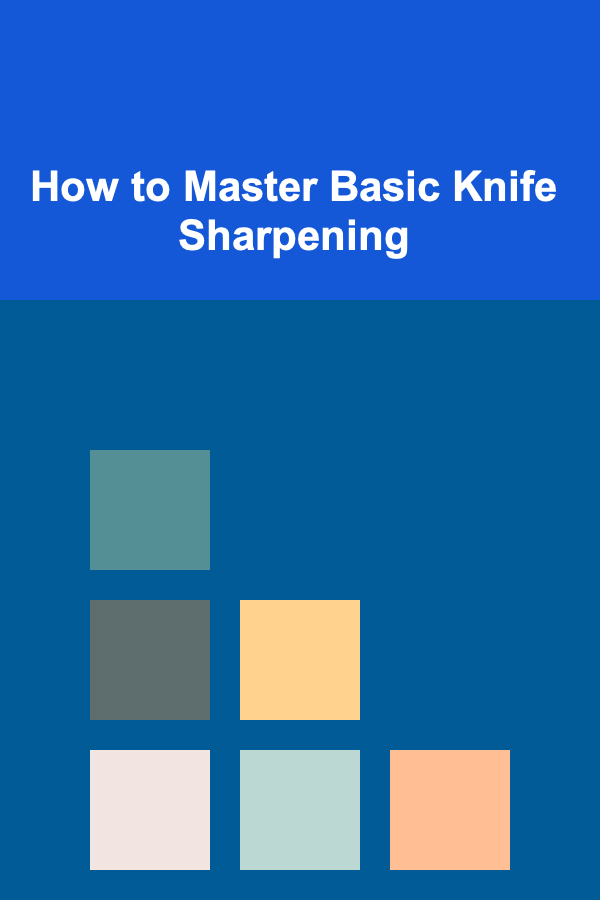
How to Master Basic Knife Sharpening
ebook include PDF & Audio bundle (Micro Guide)
$12.99$6.99
Limited Time Offer! Order within the next:

Knife sharpening is a vital skill for anyone who regularly uses knives, whether for cooking, woodworking, or other tasks. A sharp knife is safer, more efficient, and more precise than a dull one. Mastering the basics of knife sharpening not only improves the performance of your knives but also extends their lifespan. In this guide, we will explore the essential techniques and tools you need to master basic knife sharpening.
The Importance of Knife Sharpening
Before diving into the process of sharpening, it's essential to understand why sharpening is important.
1. Safety
Contrary to what some might think, dull knives are more dangerous than sharp ones. A dull knife requires more force to cut through materials, making it more likely to slip and cause accidents. A sharp knife, on the other hand, cuts smoothly and precisely, reducing the chances of mishaps.
2. Efficiency
Sharp knives allow you to work faster and with less effort. Whether you're chopping vegetables or slicing through meat, a sharp edge makes the task easier and more enjoyable.
3. Precision
When you're using a sharp knife, you have more control over the cutting process. A sharp edge makes it easier to make clean, precise cuts, which is especially important for intricate tasks such as filleting fish or making thin slices of vegetables.
4. Longevity
Sharpening a knife regularly and correctly helps to maintain its edge and prolong its life. A dull knife might seem like it can be used for a while, but over time, the edge becomes so rounded that it can't be sharpened effectively, requiring you to buy a new one sooner than necessary.
Understanding the Anatomy of a Knife
Before sharpening a knife, it's crucial to understand its components and how they relate to the sharpening process.
1. Blade
The blade is the primary cutting surface. Its edge needs to be sharp to perform tasks efficiently.
2. Spine
The spine is the top edge of the blade, opposite the edge. It is thicker and stronger, providing stability to the blade.
3. Heel
The heel is the rear part of the blade's edge. It's typically used for cutting tasks that require more force, such as chopping.
4. Tip
The tip is the front portion of the blade, useful for making delicate cuts or working with precision.
5. Tang
The tang is the portion of the blade that extends into the handle. A full tang knife extends all the way through the handle, while a partial tang does not.
Understanding the components of your knife will help you sharpen it more effectively, as each part requires slightly different attention when it comes to sharpening.
Types of Sharpening Tools
There are several tools you can use to sharpen a knife. Each tool has its advantages and is suited for different levels of experience and types of knives.
1. Sharpening Stones (Whetstones)
Whetstones are one of the most popular and versatile sharpening tools. They come in a variety of grit levels, from coarse to fine, and allow you to sharpen your knives precisely.
- Coarse Stones (200-400 grit): Used for repairing damaged or very dull knives.
- Medium Stones (800-1000 grit): Used for general sharpening and edge maintenance.
- Fine Stones (3000-8000 grit): Used for honing and polishing the blade to achieve a razor-sharp edge.
2. Sharpening Steels
Sharpening steels are long, cylindrical rods used to realign the edge of a knife rather than sharpen it. They are often used between sharpening sessions to maintain the blade's edge. They don't remove much material from the knife but are useful for keeping the knife in good condition.
3. Electric Sharpeners
Electric sharpeners are convenient and easy to use. They typically consist of two or more rotating abrasive wheels that grind the edge of the knife. They are faster than manual methods but can remove more material from the blade, potentially shortening the knife's lifespan if overused.
4. Pull-Through Sharpeners
Pull-through sharpeners are compact devices that use fixed abrasive surfaces to sharpen a knife. You pull the knife through a slot, and the abrasive surfaces sharpen the blade. These are simple and efficient but may not offer the precision or control of other sharpening methods.
5. Strops
Strops are used for polishing the edge of a knife after sharpening. They are usually made from leather or another soft material and are used to remove any remaining burrs (small bits of metal) from the edge. Strops are often used after sharpening with whetstones to give the blade a finer edge.
The Basic Sharpening Process
While there are many different sharpening tools, the basic steps remain the same. Here, we'll cover the method for sharpening a knife using a whetstone, as it's one of the most popular and effective techniques.
1. Set Up Your Whetstone
Before you begin sharpening, you need to prepare the whetstone. For most stones, you'll want to soak them in water for about 10 to 15 minutes before use. This helps the stone to grind the blade effectively and prevents it from overheating.
2. Position the Knife
Hold the knife at a consistent angle to the whetstone. A common sharpening angle is 20 degrees, but some knives may require a different angle, such as 15 degrees for Japanese knives or 25 degrees for heavy-duty knives. Maintaining this angle throughout the process is crucial for getting a consistent, sharp edge.
To find the correct angle, you can use a sharpening guide or eyeball it. The goal is to create a 20-degree angle between the blade and the stone. Some people find it helpful to visualize the angle by imagining that the blade is splitting the stone into two parts.
3. Sharpen the Knife
With the knife held at the correct angle, begin sharpening the edge by moving the blade across the stone in a sweeping motion. Start with the coarse side of the stone if the knife is dull and work your way to the finer side. Use moderate pressure, and work through the entire length of the blade, from heel to tip, ensuring even sharpening.
Start with 10 to 15 strokes on each side of the blade. If your knife is extremely dull or has a damaged edge, you may need to use more strokes.
4. Check the Blade
Periodically check the sharpness of the blade by carefully running your thumb along the edge (not across it) or by using the "paper test," where you attempt to cut through a piece of paper. If the blade is not yet sharp enough, continue sharpening.
5. Switch to the Fine Stone
Once you've sharpened the blade with the coarse side, flip the whetstone over to the fine side. Repeat the process, using light pressure and fewer strokes. The goal now is to hone the edge and remove any rough edges or burrs.
6. Polish the Blade
Finally, use a strop or a very fine stone to polish the edge. This helps refine the edge and remove any microscopic imperfections. Use light, smooth strokes for this step.
Maintaining Your Knife After Sharpening
Once you've sharpened your knife, it's essential to maintain it to keep it in good condition. Here are some maintenance tips:
1. Regular Honing
Even after sharpening, you should hone your knife regularly with a sharpening steel. Honing realigns the edge and helps maintain sharpness between sharpening sessions.
2. Proper Storage
Store your knives properly to protect the edges. A knife block, magnetic strip, or protective blade guard is ideal for keeping knives safe and preventing damage.
3. Avoiding the Dishwasher
Never put your knives in the dishwasher. The heat and movement can damage the blade and the handle. Always hand wash and dry your knives immediately after use.
4. Use a Cutting Board
To preserve the sharpness of your knife, always use a wooden or plastic cutting board. Avoid cutting on hard surfaces like glass or stone, as they can quickly dull the blade.
Conclusion
Mastering basic knife sharpening is a valuable skill that can significantly improve your cooking and other activities. By understanding the anatomy of a knife, selecting the right sharpening tools, and practicing the correct techniques, you can maintain your knives in top condition for years to come. With consistent practice, you'll gain the confidence and skill to sharpen any knife in your collection.

How to Choose the Right Tools and Products for Manicures and Eyelashes
Read More
How to Soundproof Your Floors and Prevent Noise from Below
Read More
How to Upgrade Your Home's Insulation During Renovations
Read More
How to Master Stunt Kiting
Read More
Exploring the Power of Mantras in Yoga: A Deep Dive
Read More
10 Tips for Improving Your Archery Form and Consistency
Read MoreOther Products

How to Choose the Right Tools and Products for Manicures and Eyelashes
Read More
How to Soundproof Your Floors and Prevent Noise from Below
Read More
How to Upgrade Your Home's Insulation During Renovations
Read More
How to Master Stunt Kiting
Read More
Exploring the Power of Mantras in Yoga: A Deep Dive
Read More